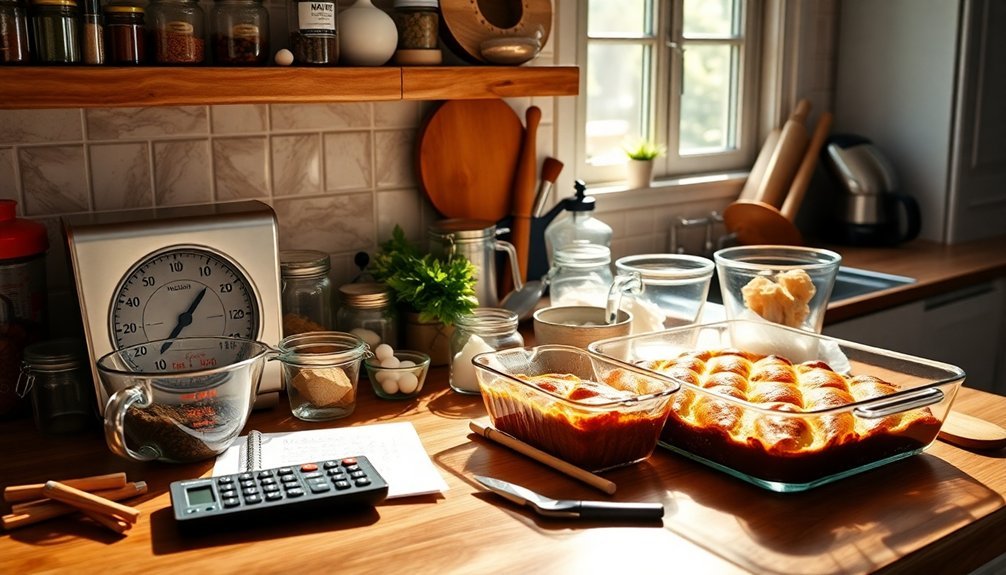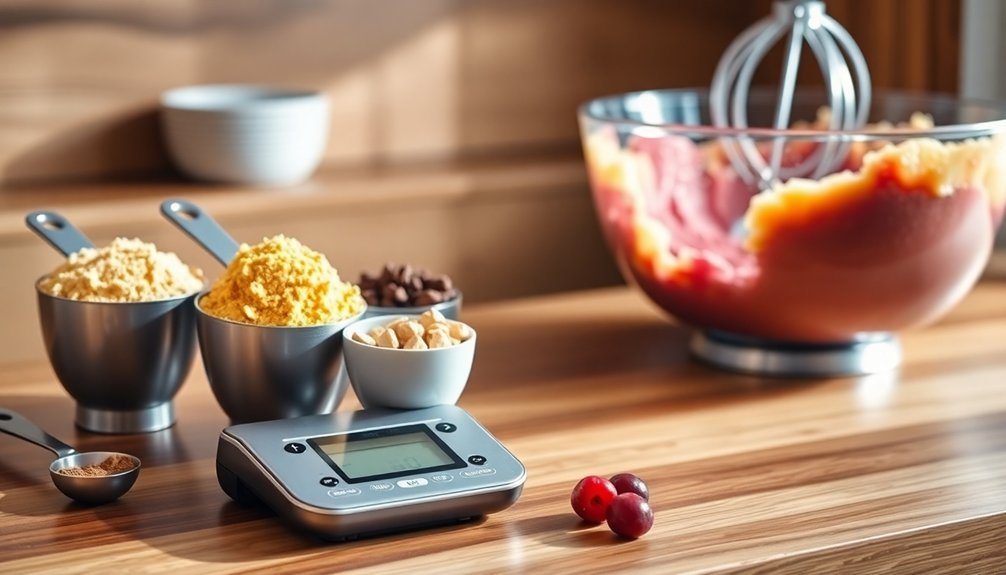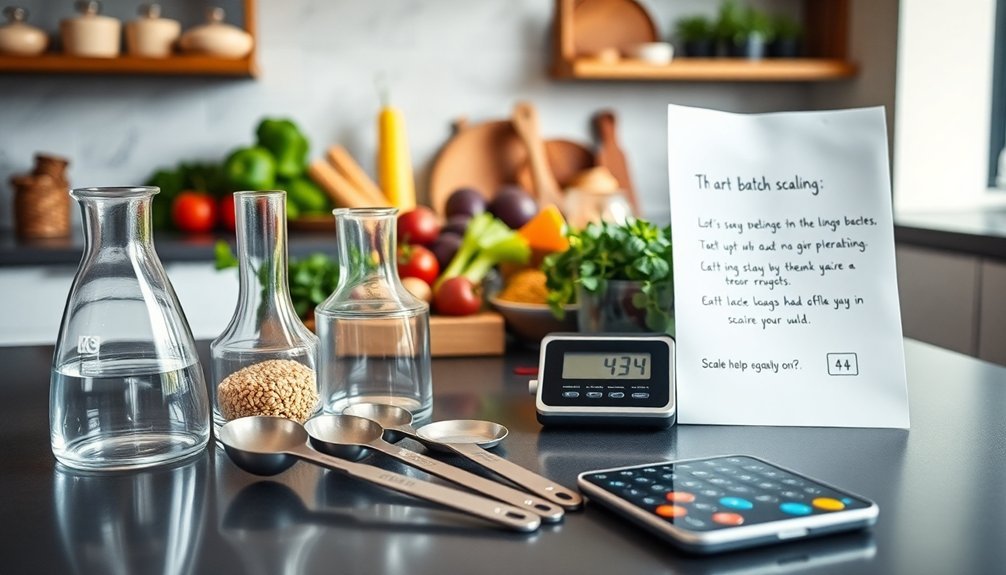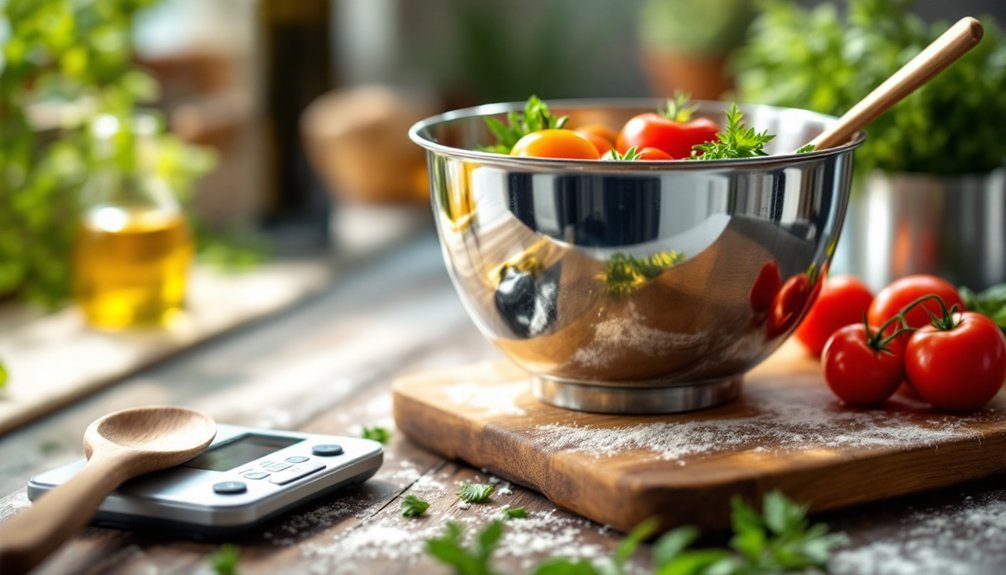Batch size math lets you confidently scale any recipe by using conversion factors—divide your desired yield by the original yield to get your multiplier. Always weigh ingredients rather than using volume measurements for precision, and maintain consistent ingredient ratios to preserve quality. You'll need to adjust equipment size accordingly, operating mixers at 75% capacity for batters and 50-60% for doughs. Master these principles, and you'll transform from cautious cook to scaling superhero.
Batch Size Math: Adjust Any Recipe Confidently

Whether you're baking for a crowd or cooking for one, mastering batch size math transforms your kitchen capabilities. The key to accurately scale the recipe lies in converting ingredient amounts to weights and calculating their percentages based on total yield. This approach guarantees consistent results every time.
Precision in the kitchen starts with numbers—weigh, calculate, and scale for foolproof results every time.
When doubling a recipe, calculate your conversion factor by dividing your desired yield by the original yield. Then multiply each ingredient by this factor.
Remember that scaling recipes isn't just about ingredients—baking time and pan sizes often need adjustment too. Larger batches may require longer cooking times, while smaller ones might finish faster.
For precise results, try the baker's percentage method, which expresses ingredients as percentages of flour weight. Document your adjustments to build a reliable reference for future cooking projects.
Understanding Conversion Factors: The Foundation of Recipe Scaling
You'll find conversion factors at the heart of any successful recipe scaling, calculated simply by dividing your desired yield by the original recipe yield.
When you understand these mathematical ratios, you can confidently multiply each ingredient to maintain perfect proportions, whether you're doubling a family recipe or scaling for a large event.
Converting all measurements to weight units rather than volume guarantees your scaled recipes maintain consistency and quality across different batch sizes.
Understanding Conversion Factors: The Foundation of Recipe Scaling
Three fundamental steps are necessary when scaling any recipe, with conversion factors standing as the mathematical backbone of the entire process.
You'll calculate this essential ratio by dividing your desired yield by the original recipe yield. For instance, to scale a recipe from 25 to 60 portions, your conversion factor is 2.4 (60 ÷ 25 = 2.4).
Once determined, simply multiply each ingredient quantity by this factor to achieve precise adjustments.
When scaling the recipe, always prioritize weight measurements over volume for greater accuracy—especially with dry ingredients. This methodical approach guarantees consistent results regardless of batch size.
Maintaining records of your converted recipes and their corresponding factors creates a valuable reference library, allowing you to confidently scale recipes for any future cooking or baking project.
Calculate Precise Ratios
Precise mathematical calculations form the backbone of successful recipe scaling. When you need to adjust batch sizes, calculating the exact conversion factor guarantees your results remain consistent regardless of quantity.
To calculate precise ratios, divide your desired yield by the original recipe yield. For instance, if scaling from 25 to 60 portions, your conversion factor would be 2.4 (60 ÷ 25 = 2.4). Multiply each ingredient amount by this factor to maintain perfect proportions.
For maximum accuracy, express ingredients by weight rather than volume, especially dry ingredients that might settle or compress.
After applying your conversion factor to all components, document your adjusted recipes for future reference. This documentation preserves your successful scaling efforts and assures you can reproduce excellent results consistently across different batch sizes.
Unit Measurement Basics
Mastering the basics of unit measurement provides the essential groundwork for successful recipe scaling in any kitchen environment.
When you need to adjust recipe yields, conversion factors become your most reliable tool. Calculate these factors by dividing your required yield by the original recipe yield—this single number becomes your multiplier for all ingredients.
For precision, always measure by weight rather than volume when you scale a recipe. A conversion factor of 2.4 (when scaling from 25 to 60 portions) means each ingredient weight gets multiplied by exactly that amount.
This mathematical approach guarantees that your adjusted recipes maintain their intended flavor profiles and textures, regardless of batch size.
Document your successfully adjusted recipes, noting both the conversion factor and measured weights, to build efficiency into your future cooking projects.
Calculating Ingredient Percentages for Precise Soap Formulations
When developing soap formulations, you'll need to understand how to calculate ingredient percentages to confirm consistency across different batch sizes. Start by determining the total weight of all ingredients, then divide each component's weight by this total and multiply by 100.
For example, with 200g of oils and 50g of lye (250g total), your oils represent 80% and lye 20%.
- Always include additives and essential oils in your total weight calculations for accurate percentages
- Maintain ingredient ratios when scaling by applying these calculated percentages to new batch sizes
- Use a digital scale measuring in grams for maximum precision in soap making
This percentage-based approach confirms your soap quality remains consistent whether you're making a small test batch or scaling up for production.
Adjusting Measurements From Small Test Batches to Production Size

When scaling up from test batches to production size, you'll need reliable conversion formulas that accurately maintain ingredient proportions while avoiding the common pitfall of simply multiplying all ingredients equally.
You might encounter unexpected issues with reaction times, mixing challenges, and heat distribution as batch sizes increase dramatically.
Don't forget to factor in equipment size considerations, as your production vessels must accommodate not only the final volume but also allow sufficient headspace for mixing and potential expansion during processing.
Reliable Conversion Formulas
To scale your culinary creations from small test batches to full production size, you'll need reliable conversion formulas that maintain product quality and consistency. The most dependable approach is calculating your conversion factor: simply divide your desired yield by the original yield. Then multiply the weight of each ingredient by this factor to scale any recipe accurately.
- Always convert measurements to grams first—weight-based measurements provide precision that volume measurements can't match.
- Document both your original recipes and scaled versions, noting any adjustments to bake times or cooking techniques.
- Remember that doubling a recipe doesn't always mean doubling cooking time—test and adjust accordingly.
This mathematical approach guarantees your scaled-up production maintains the same quality and flavor profile that made your test batch successful.
Common Scaling Pitfalls
Despite the straightforward mathematics of batch conversion, scaling recipes from test kitchen to production often introduces unexpected challenges that can derail your final product.
When scaling recipes, maintaining consistent ingredient ratios is essential. Even small deviations can compromise quality and flavor profiles. You'll need to account for evaporation loss in larger batches, particularly with liquids, requiring water percentage adjustments to maintain the proper consistency.
Your mixing techniques must adapt as batch size increases. Overloading equipment leads to uneven distribution and inconsistent results. Always verify equipment capacity before scaling up—larger volumes often demand different tools or bakeware to guarantee even cooking.
Be especially careful with taste adjustments. Simply multiplying herbs and spices proportionally can create overwhelming flavors in production-sized batches, requiring more nuanced calculation approaches.
Equipment Size Considerations
Scaling up your recipe requires more than just multiplying ingredients—your equipment must grow proportionally too.
When moving from test batches to production, guarantee your mixing bowls can handle increased volumes—aim for 75% capacity with batters and 50-60% for doughs to prevent overflow during mixing.
For larger batches, you'll need to:
- Invest in commercial mixers designed for heavy loads without exceeding the equipment's capacity
- Select appropriately sized baking dishes and pans to prevent overcrowding and guarantee even cooking
- Adjust cooking times as larger quantities typically require longer to cook thoroughly, especially in deeper containers
Always verify your equipment's limitations before beginning production.
Overloaded equipment leads to poor mixing, inconsistent results, and potential damage to your tools—costing you time and money.
Essential Tools and Equipment for Accurate Batch Scaling

Five vital tools stand at the foundation of successful recipe scaling. First, invest in a digital kitchen scale that measures ingredients in both grams and ounces for precise ingredient amounts. This essential tool eliminates the guesswork that often derails scaled recipes.
You'll need appropriately sized mixing bowls to accommodate larger quantities without overflow, especially important for batch baking. Understanding your equipment's capacity limits—whether it's your stand mixer or oven—prevents quality issues when scaling up.
Choose recipes with metric measurements to simplify your calculations, as they're easier to multiply than imperial units.
Finally, keep a calculator or spreadsheet handy to quickly adjust ingredient quantities and organize your scaled recipe. These tools guarantee consistency and success when adapting recipes to any size.
Common Pitfalls When Scaling Traditional Soap Recipes
When you adjust traditional soap recipes to larger or smaller batches, maintaining precise chemical ratios becomes your primary challenge. The lye to oils relationship must remain mathematically exact regardless of batch size. Always recalculate the total weight of all oils and butters to guarantee proper saponification and avoid safety hazards.
- Scaling up recipes generates more heat during saponification, potentially altering your soap's texture and appearance.
- Additives like fragrances and colorants need careful recalculation—their percentages greatly affect larger batches.
- Inadequate mixing and curing equipment for your new batch size can lead to uneven mixing and messy spills.
Remember that successful batch scaling isn't just about multiplying ingredients—it requires thoughtful adjustment of every component and consideration of how chemical reactions change with volume.
Frequently Asked Questions
What Is the Formula Used to Adjust the Serving Size of a Recipe?
To adjust a recipe's serving size, you'll divide your desired yield by the original yield to get a conversion factor. Then you'll multiply all ingredient amounts by this factor to determine new quantities needed.
What Is the Formula for Finding the Conversion Factor to Adjust a Recipe Yield?
To find the conversion factor for adjusting recipe yield, divide your desired yield by the original yield. You'll use this formula: Conversion Factor = Desired Yield ÷ Original Yield. Then multiply all ingredient amounts by this factor.
What Adjustments Should You Keep in Mind When Doubling a Recipe?
When doubling a recipe, you'll need to multiply ingredients by two, use larger preparation tools, adjust cooking times cautiously, increase herbs by only 1.5 times, and mix thoroughly for consistent results, especially with delicate baked goods.
What Is the Most Common Way to Adjust Recipes Is to Use the Conversion Factor Method?
Yes, you'll find the conversion factor method is the most common approach for adjusting recipes. You simply divide your desired servings by the original amount, then multiply each ingredient by that ratio.
In Summary
You've now mastered the basic principles of batch size math for soap making. Armed with conversion factors and ingredient percentages, you'll confidently scale recipes from test batches to full production. Remember to use proper tools for accuracy and watch for those common pitfalls. With practice, you'll transform any soap formula to your desired batch size while maintaining perfect proportions and quality.





Leave a Reply